Topic 2, Exam Pool B
Refer to the exhibit.
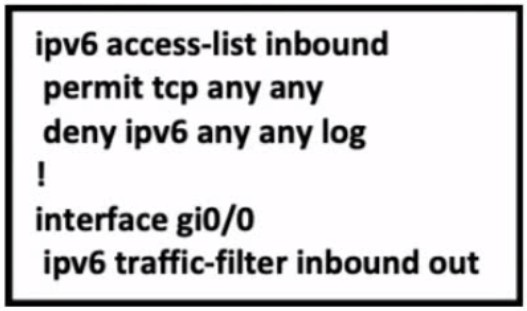
A network administrator configured an IPv6 access list to allow TCP return frame only, but it is not working as expected. Which changes resolve this issue?
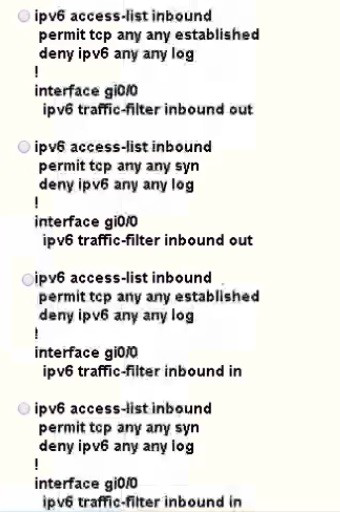
A.
Option A
B.
Option B
C.
Option C
D.
Option D
Option C
Which configuration feature should be used to block rogue router advertisements instead of using the IPv6 Router Advertisement Guard feature?
A.
VACL blocking broadcast frames from nonauthorized hosts
B.
PVLANs with promiscuous ports associated to route advertisements and isolated ports for nodes
C.
PVLANs with community ports associated to route advertisements and isolated ports for nodes
D.
IPv4 ACL blocking route advertisements from nonauthorized hosts
PVLANs with promiscuous ports associated to route advertisements and isolated ports for nodes
Refer to the exhibit.
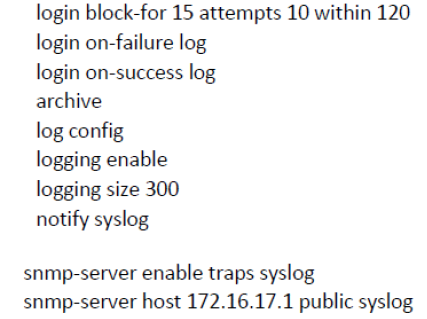
The administrator can see the traps for the failed login attempts, but cannot see the traps of successful login attempts. What command is needed to resolve the issue?
A.
Configure logging history 2
B.
Configure logging history 3
C.
Configure logging history 4
D.
Configure logging history 5
Configure logging history 5
Drag and drop the MPLS VPN device types from the left onto the definitions on the right.




What are two functions of MPLS Layer 3 VPNs? (Choose two.)
A.
LDP and BGP can be used for Pseudowire signaling.
B.
It is used for transparent point-to-multipoint connectivity between Ethernet links/sites.
C.
BGP is used for signaling customer VPNv4 routes between PE nodes.
D.
A packet with node segment ID is forwarded along with shortest path to destination.
E.
Customer traffic is encapsulated in a VPN label when it is forwarded in MPLS network.
BGP is used for signaling customer VPNv4 routes between PE nodes.
Customer traffic is encapsulated in a VPN label when it is forwarded in MPLS network.
Refer to Exhibit.

The network administrator configured the branch router for IPv6 on the E0/0 interface. The neighboring router is fully configured to meet requirements, but the neighbor relationship is not coming up. Which action fixes the problem on the branch router to bring the IPv6 neighbors up?
A.
Enable the IPv4 address family under the router ospfv3 4 process by using the addressfamily ipv4 unicast command
B.
Disable IPv6 on the E0/0 interface using the no ipv6 enable command
C.
Enable the IPv4 address family under the E0/0 interface by using the address-family ipv4 unicast command
D.
Disable OSPF for IPv4 using the no ospfv3 4 area 0 ipv4 command under the E0/0 interface
Enable the IPv4 address family under the router ospfv3 4 process by using the addressfamily ipv4 unicast command
Refer to the exhibit.
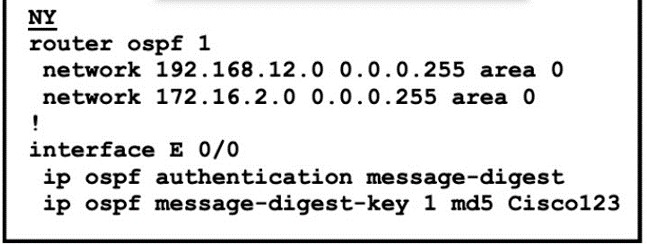
The neighbor relationship is not coming up Which two configurations bring the adjacency up? (Choose two)
A.
NY
router ospf 1
area 0 authentication message-digest
B.
LA
interface E 0/0
ip ospf message-digest-key 1 md5 Cisco123
C.
NY
interface E 0/0
no ip ospf message-digest-key 1 md5 Cisco123
ip ospf authentication-key Cisco123
D.
LA
interface E 0/0
ip ospf authentication-key Cisco123
E.
LA
router ospf 1
area 0 authentication message-digest
LA
interface E 0/0
ip ospf message-digest-key 1 md5 Cisco123
LA
router ospf 1
area 0 authentication message-digest

A.
Option A
B.
Option B
C.
Option C
D.
Option D
Option D
An engineer configured VRF-Lite on a router for VRF blue and VRF red. OSPF must be enabled on each VRF to peer to a directly connected router in each VRF. Which configuration forms OSPF neighbors over the network 10.10.10.0/28 for VRF blue and 192.168.0.0/30 for VRF red?
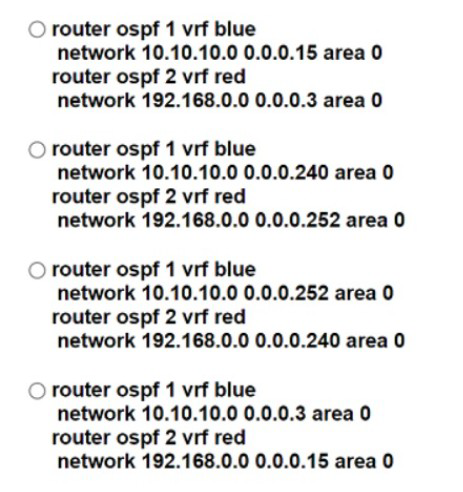
A.
Option A
B.
Option B
C.
Option C
D.
Option D
Option A
An engineer is creating a policy that overrides normal routing behavior.if the route to a destination of 10.100.100.0/24 is withdrawn from the routing Table, the policy must direct traffic to a next hop of 10.1 1.1. if the route is present in the routing table, then normal forwarding must occur. Which configuration meets the requirements?
A.
access-list 100 permit ip any any
!
route-map POLICY permit 10
match ip address 100
set ip next-hop recursive 10.1.1.1
B.
access-list 100 permit ip any 10.100.100.0 0.0.0.255
!
Route-map POLICY permit 10
match ip address 100
set ip default next-hop 10.1.1.1
C.
access-list 100 permit ip any 10.100.100.0 0.0.0.255
!
route-map POLICY permit 10
match ip address 100
set ip next-hop 10.1.1.1
!
route map POLICY permit 20
D.
access-list 100 permit ip any 10.100.100.0 0.0.0.255
!
route map POLICY permit 10
match ip address 100
Set ip next-hop recursive 10.1.1.1
!
route-map POLICY permit 20
access-list 100 permit ip any 10.100.100.0 0.0.0.255
!
route map POLICY permit 10
match ip address 100
Set ip next-hop recursive 10.1.1.1
!
route-map POLICY permit 20
Refer to the exhibit.
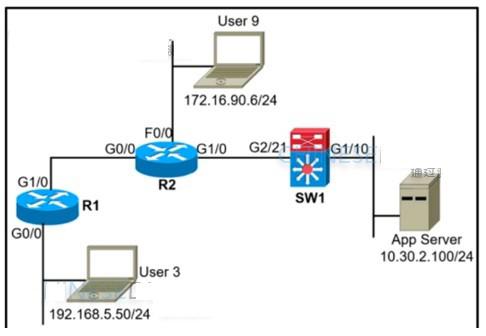
A network administrator must block ping from user 3 to the App Server only. An inbound standard access list is applied to R1 interface G0/0 to block ping. The network administrator was notified that user 3 cannot even ping user 9 anymore. Where must the access list be applied in the outgoing direction to resolve the issue?
A.
R2 interface G1/0
B.
R2 interface G0/0
C.
SW1 interface G1/10
D.
SW1 interface G2/21
SW1 interface G2/21
| Page 19 out of 47 Pages |
| Previous |